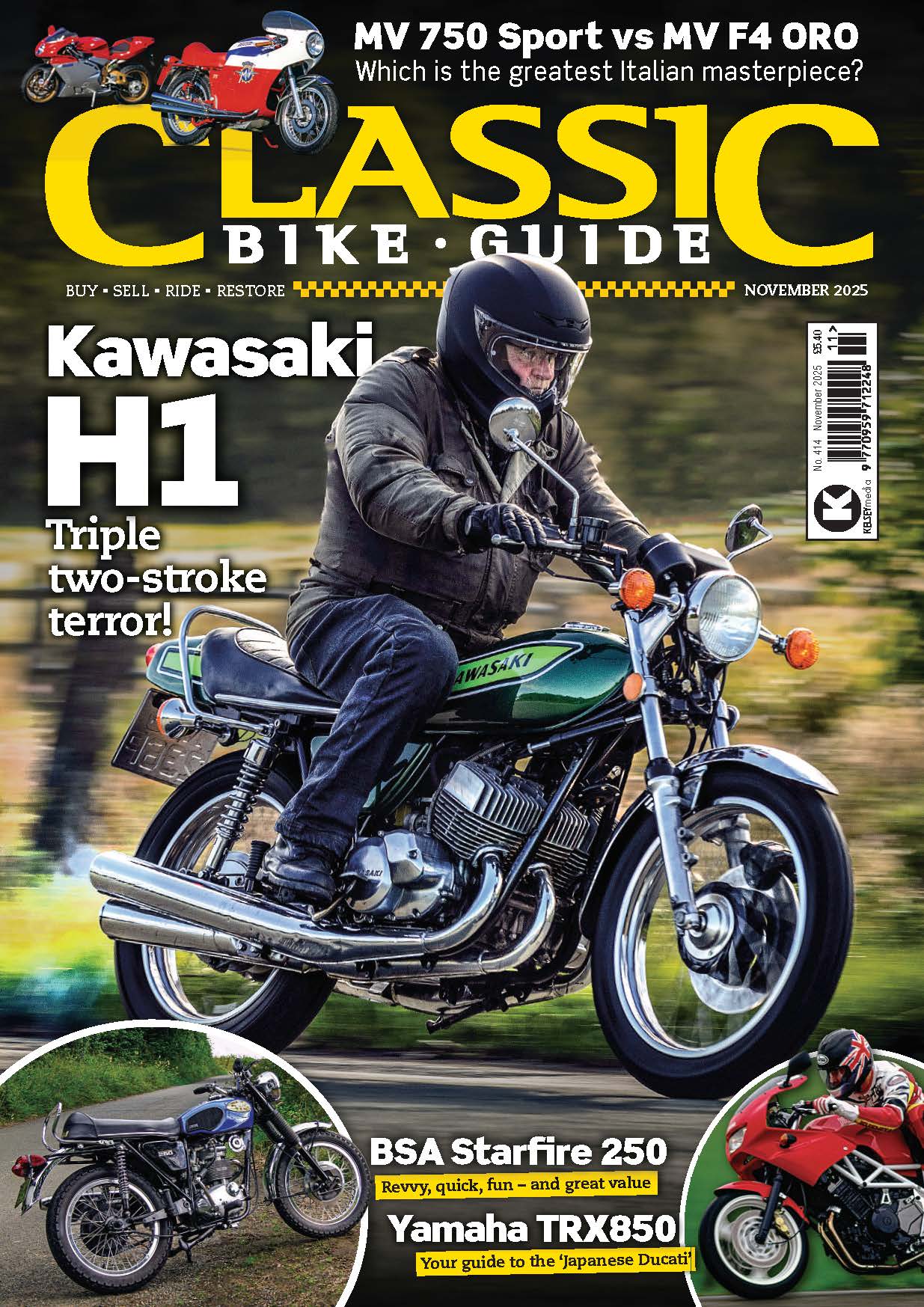Velocettes have a fantastic racing pedigree and are an engineer’s delight. Built solidly, they can also provide a brilliant ride, and the MSS is one of the most useable models for sensible cost.

Words by Oli Hulme, with photography by Matt Hull
The purposeful Velocette MSS 500 was the quintessential British big single and a cut above the rest at the same time. Upper class and expensive when new, a black and gold Velocette was the machine of choice for the well-heeled enthusiast; at least, one who was not well-heeled enough for a Vincent. Put one next to a more proletarian BSA B33 or AJS Model 18 and the difference is marked, as is the ownership and riding experience.
The MSS initially arrived in the mid-1930s as the third in Velocette’s range of OHV high-cam, short pushrod singles. These started with the 250cc MOV, which was followed by the 350 MAC. The first MSS engine had the long 96mm stroke from the 350 engine with an 81mm bore, creating a 495cc long-stroke motor. Although it looked like its smaller siblings, it was proportionally larger in most aspects. The bigger engine needed a heavyweight frame and Velocette built a rigid, derived from the Mk. V KTT racer, with Webb-type girder forks. The frame was shared with the Mk. II overhead camshaft KSS/KTS.
Enjoy more classic motorcycle reading, Click here to subscribe to one of our leading magazines.
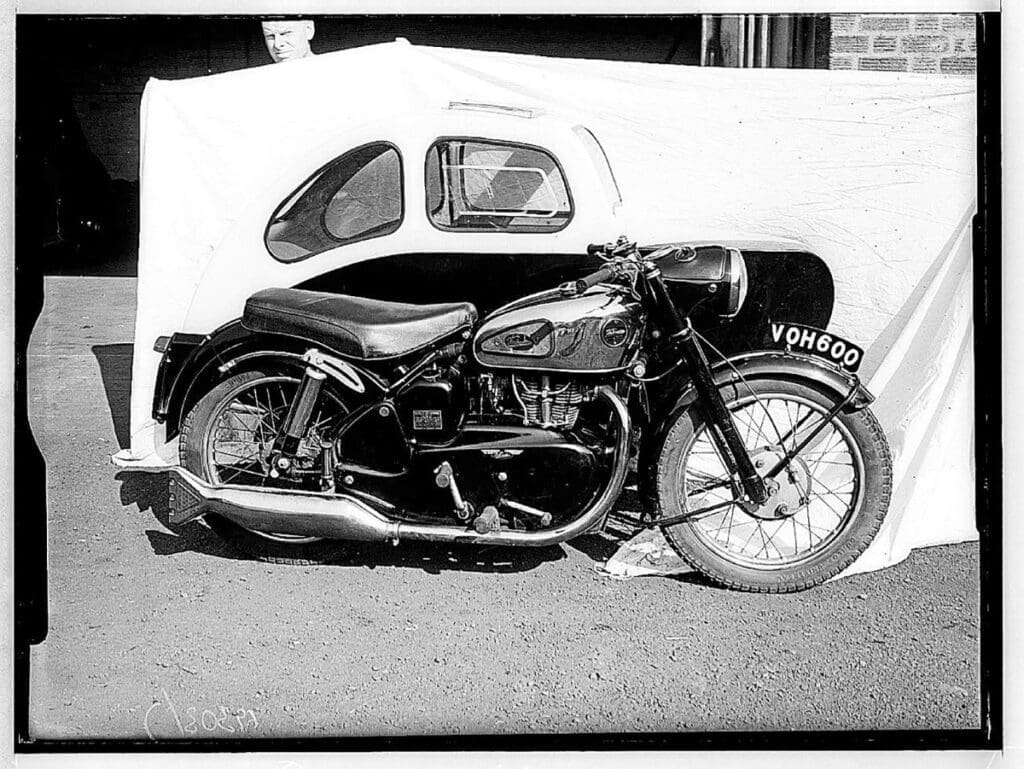
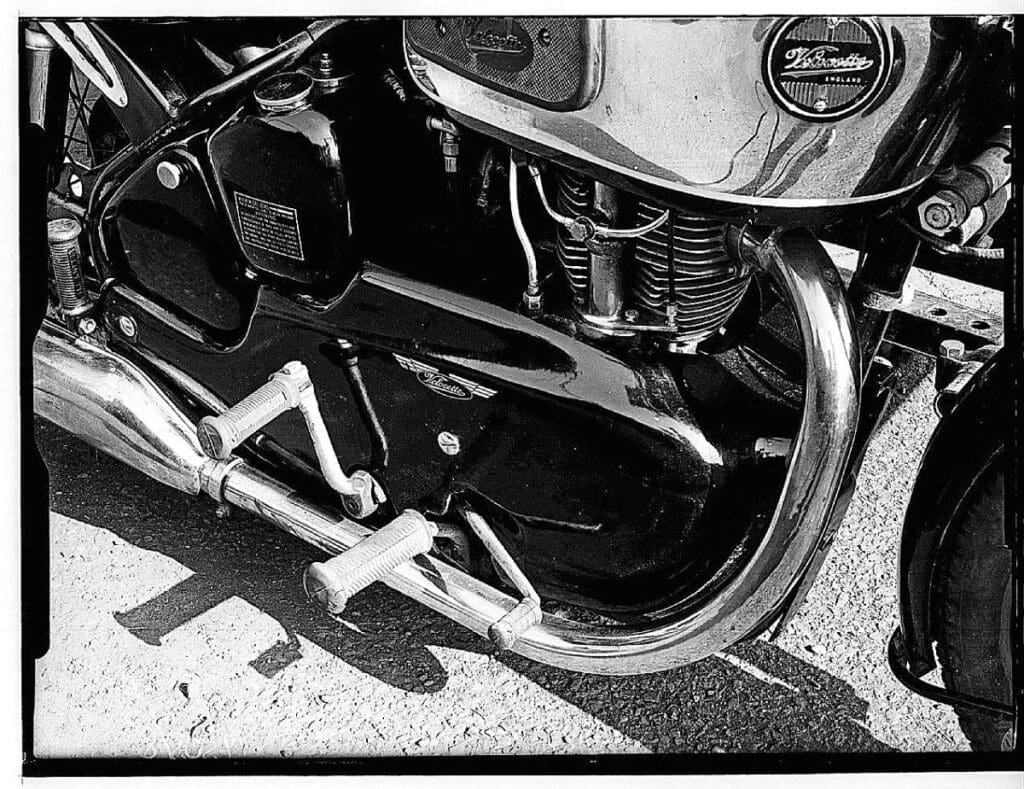
Then, of course, war intervened and luxury civilian machine production at the Hall Green factory was turned over to making military versions of the MAC, MAF and MDD, as well as other war work including making tin helmets.
The company made a significant contribution not just to war work, but also to the future of motorcycle development. It was an automatic advance/retard mechanism it had developed with BTH, and Velocette gave up the rights to the design to help with the war effort.
From 1948, Velocette turned its attention to building the revolutionary side valve, flat-twin LE it had been developing during the war. It also reintroduced the MAC, first in a rigid frame with girders and then with innovative, air-sprung Dowty Oleomatic forks. In 1951, these were upgraded to Veloce ‘tele forks.’ The old frame was replaced by a sprung frame with Velocette’s signature sliding upper rear shock mount.
A new version of the 500 MSS caused a stir when it appeared at the Earls Court Show in 1954. The new MSS arrived in the MAC frame, with a new light-alloy engine that used square dimensions of 86mm bore and stroke and featured hairpin valve springs and a bonded-in iron cylinder liner. The output of just 25bhp sounds modest today but was typical for the time. The move to a ‘square’ bore and stroke was mostly prompted so the 500 engine would fit into the shorter MAC frame. The MSS motor had a narrow, extremely rigid bottom end assembly with taper roller main bearings and moderate valve timing. The motor was tuned for low-rev torque for everyday use, sidecar hauling and good fuel economy.
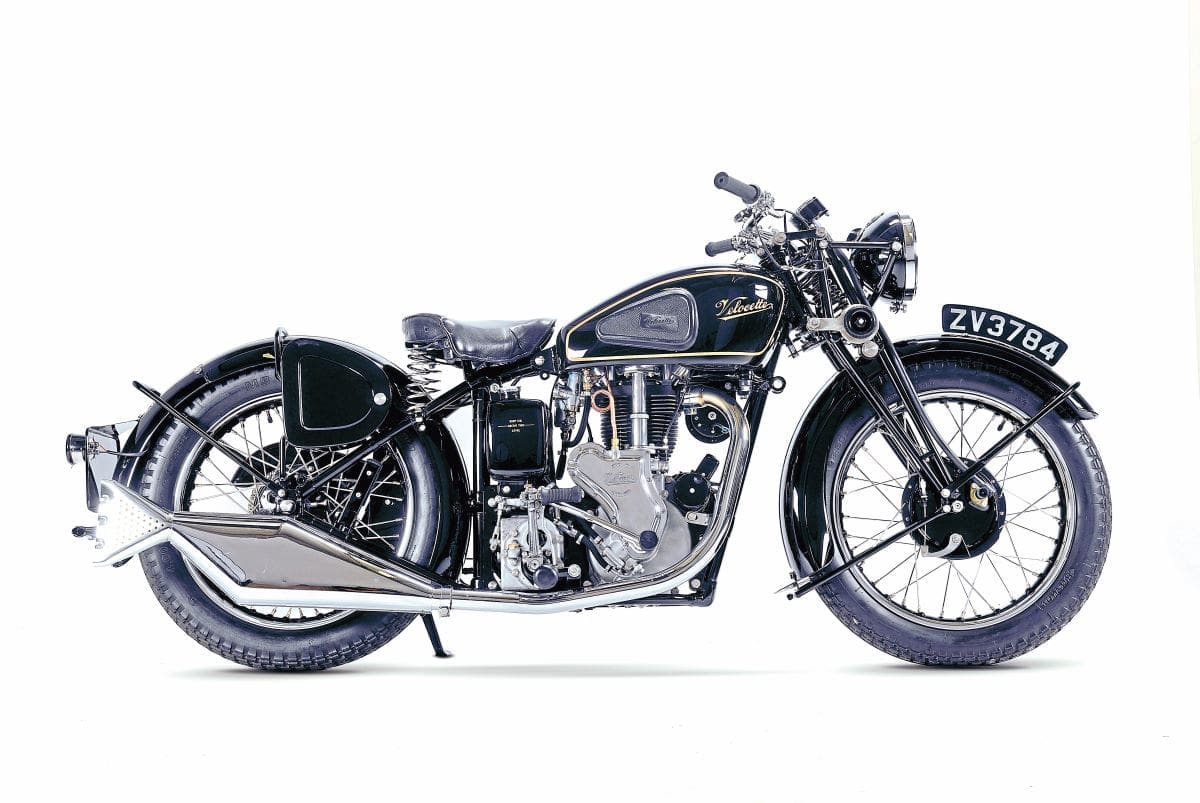
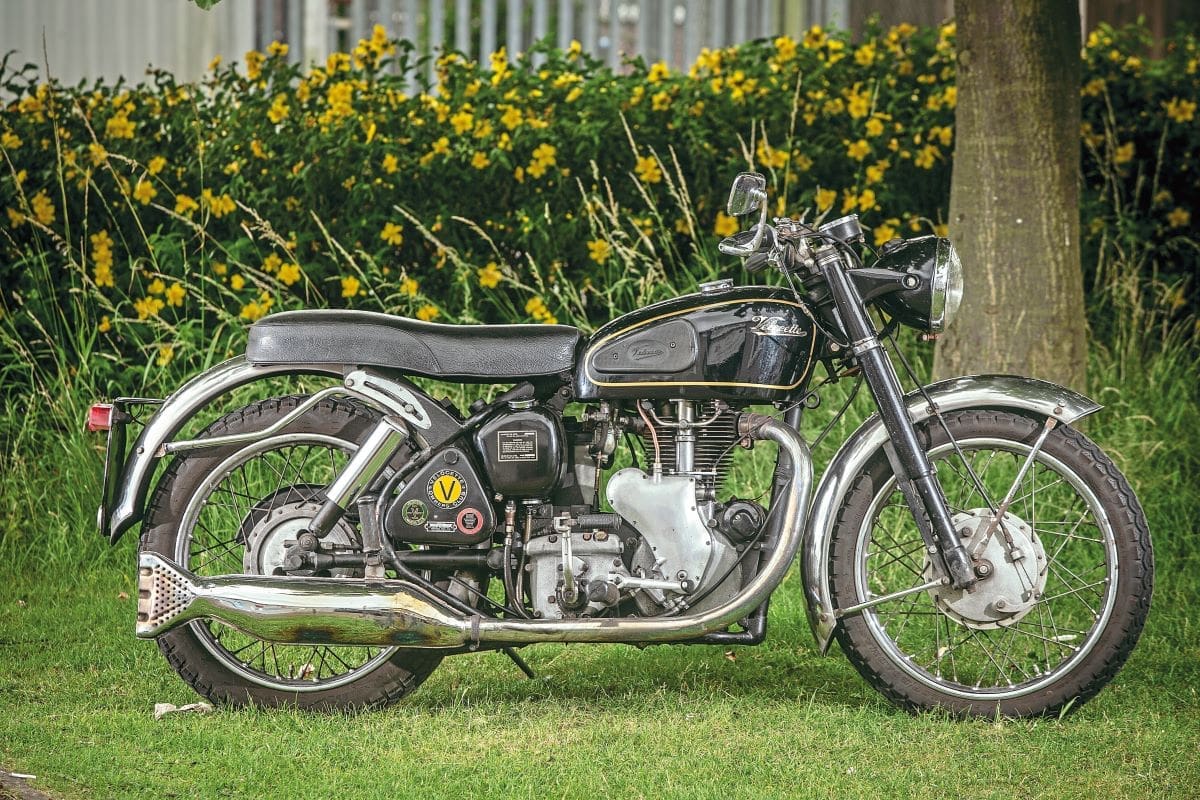
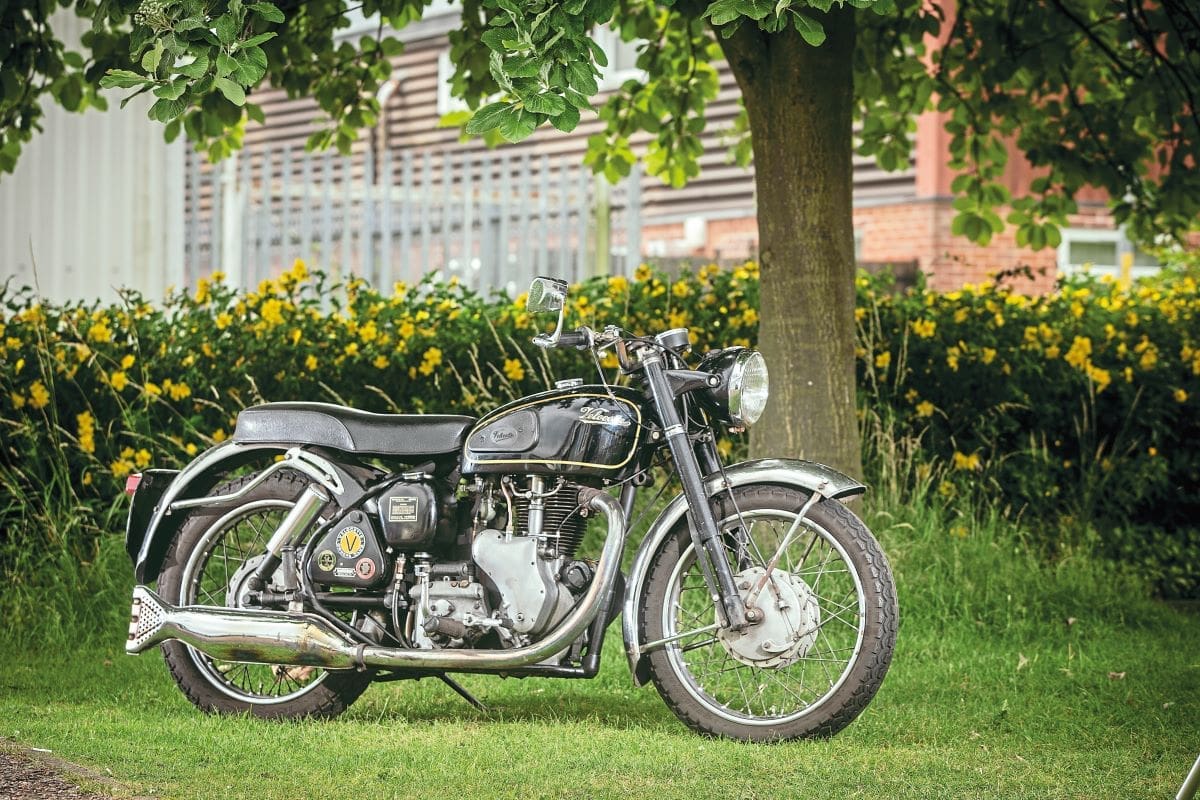
The crankcase, indestructible rockers and high-quality timing gear helped cement Velocette’s reputation for engines of robustness and silent operation. Velocette designers Eugene Goodman and Charles Udall had taken some inspiration for their engine from a Riley car, which had two camshafts mounted high up on the block. The genius of the Velocette design came from the realisation that by mounting the camshaft high up, under the signature ‘map of Africa’ timing cover and fitting short pushrods, the effect was to create an engine with the similar characteristics to an overhead cam engine. The camshaft was unique in using fine pitch helical timing gears, making the mechanical operation of the engine almost silent, in a world where the clatter of valve gear was the signature noise of a big single. The short pushrods also reduced the stress on the valve springs.
Charles Udall told The Motor Cycle in 1955: “Provided the gears are manufactured accurately and mounted correctly, the drive maintains its efficiency for the total life of the engine. It is more difficult to make to make a gear drive as quiet as a chain drive, but it is a question of maintaining the necessary degree of accuracy in the gears. A chain drive, however well it is arranged, suffers from the fact that the chain stretches during its life and ultimately must be replaced.”
The shorter stroke extended the working life of more key engine components: lower piston speeds reduced wear to the piston itself, rings and bore. The broad bore also provided plenty of space for tuning, with the development of the sportier Scrambler, Venom, Venom Clubman and Thruxton machines.
The flywheel assembly was apart from the norm, with the crankpin a press fit in the flywheels, which were steel stampings, long needle rollers that used almost all of the bearing surface and the oil flung centrifugally from internal drillings through the bearing rather than the outside of it. In the cylinder head were KTT-style hairpin valve-springs and the valves could rotate in their guides.
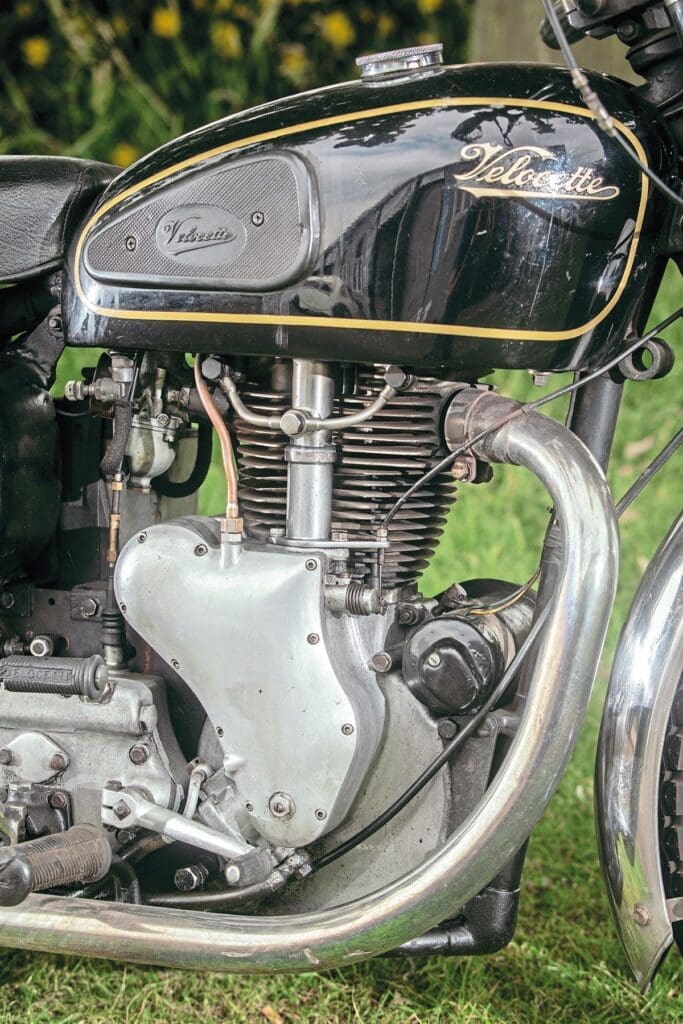
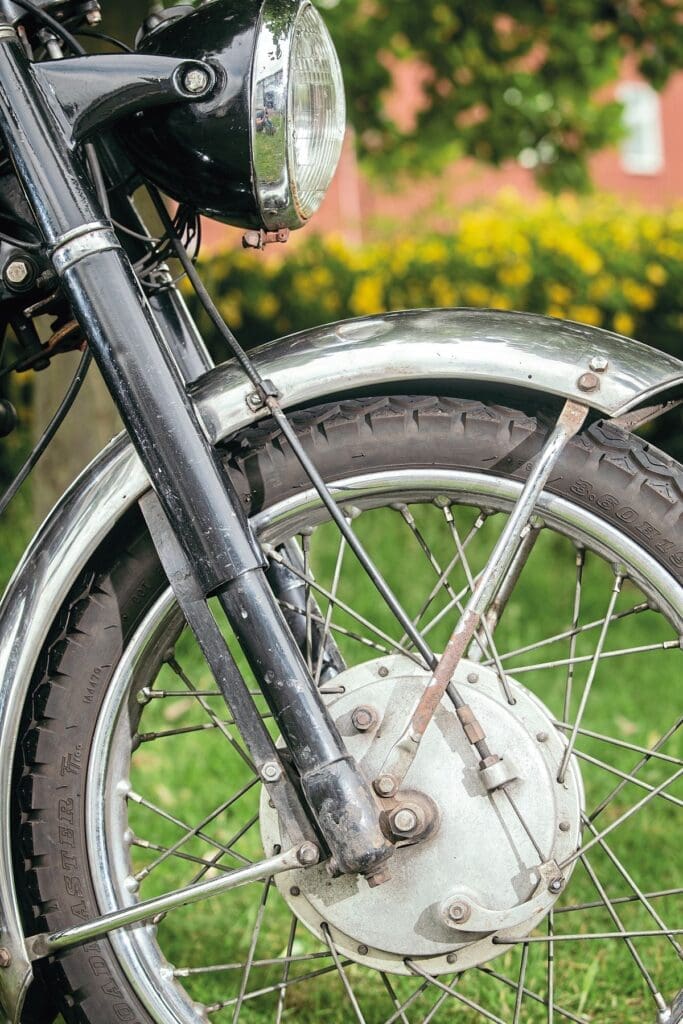

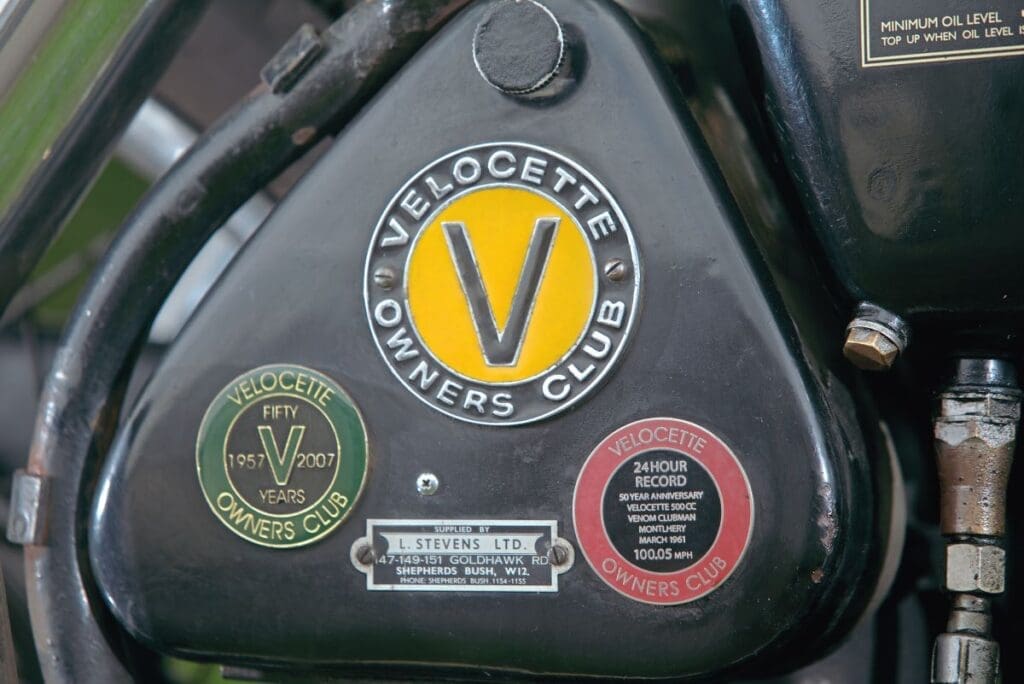
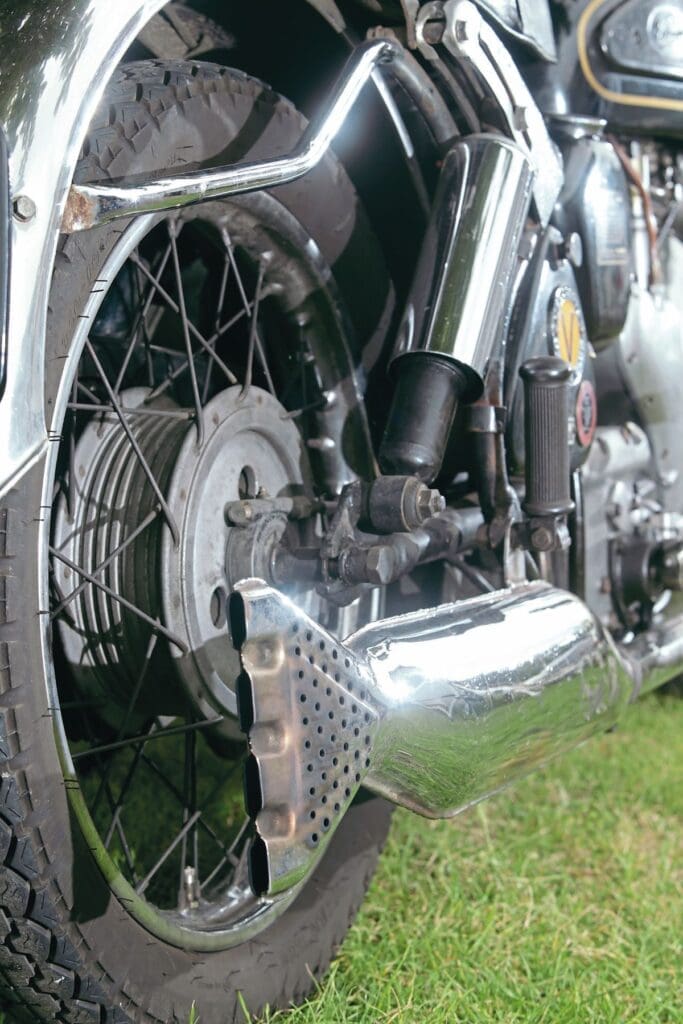
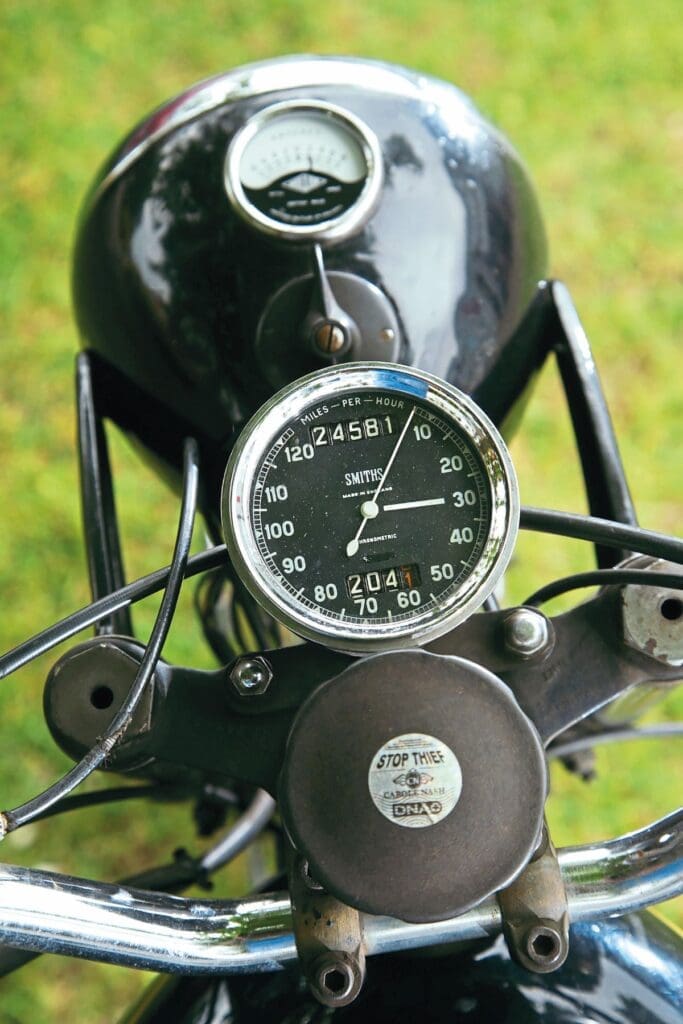
The Veloce forks were matched with Woodhead-Monroe or Girling adjustable rear suspension, depending on what the factory had in stock at the time, which could be adjusted for solo or pillion use by sliding them in the mounting slots. Early bikes had seats with two levels but went to a more modern flat item in 1955. The early bikes also had half-width brake hubs, but later the full-width cast-iron 7.5in front brake and 7in rear were generally fitted, which are excellent for a single leading shoe item. MSS models had steel painted mudguards as stock items and the standard Velocette silencer with the distinctive ‘woof’ that marked the bike different to rivals.
The 499cc MSS developed a reputation for being one of the most user-friendly Velo four-strokes around. A well-mannered and practical, yet sporting single, in its final versions it could almost top 100mph and if ridden in a moderately conservative fashion, 100mpg. With a broad spread of torque, the MSS offered a rewarding yet relaxed ride over longer distances.
In the late 1950s and into the mid-1960s, Velocette embraced the idea of streamlined enclosures, which had become a trend at the time, heavily promoted by journalists at motorcycle publications. This led to fitting the MSS with a large glass-fibre lower engine fairing. While the left-hand side of the engine benefitted from this as it was an unattractive collection of pressed steel covers, the right-hand side cover enclosed the engine’s signature alloy casings. It saved Velocette money as the casings no longer needed to be polished and the dynamo and final drive sprocket covers could be deleted. The downside was that the enclosures needed to be removed before any work was done, which made day-to-day maintenance a bind for owners. Originally a standard fixture, later the casing was offered as an option instead. As bikes got older, more second-hand owners removed the casings, and the missing dynamo and sprocket covers were replaced by owners preferring the classic look. These now surplus casings were usually binned, which makes the hunt for parts to return machines to original spec something of a challenge. On later models, the old black and gold classic look was revamped with a larger, squarer petrol tank fitted with a clip-on polished strip above the engine and plastic badges.

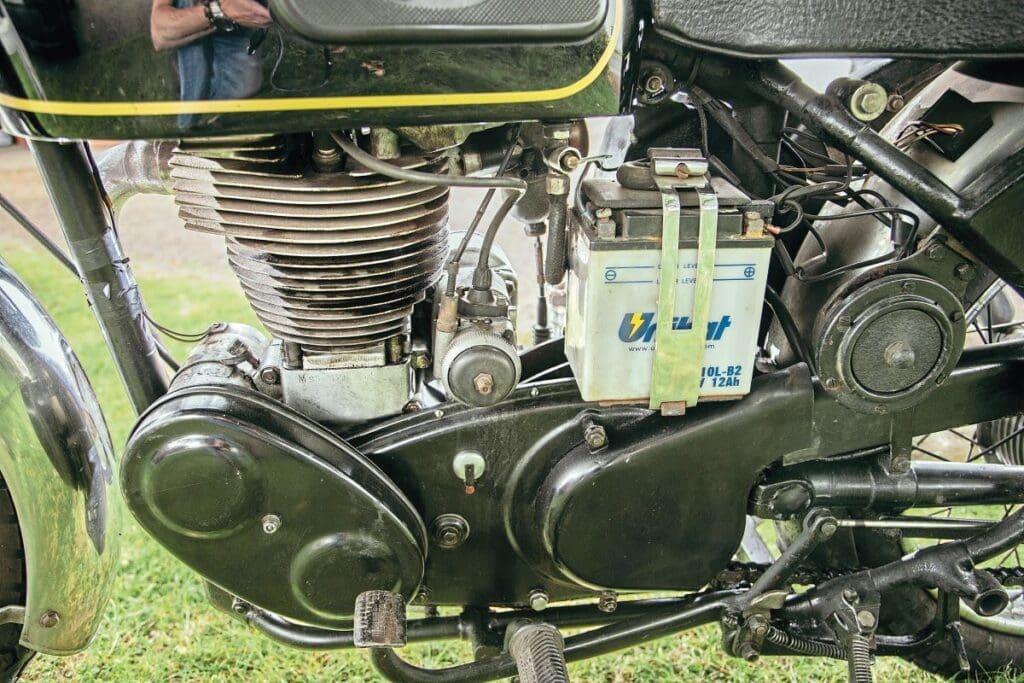

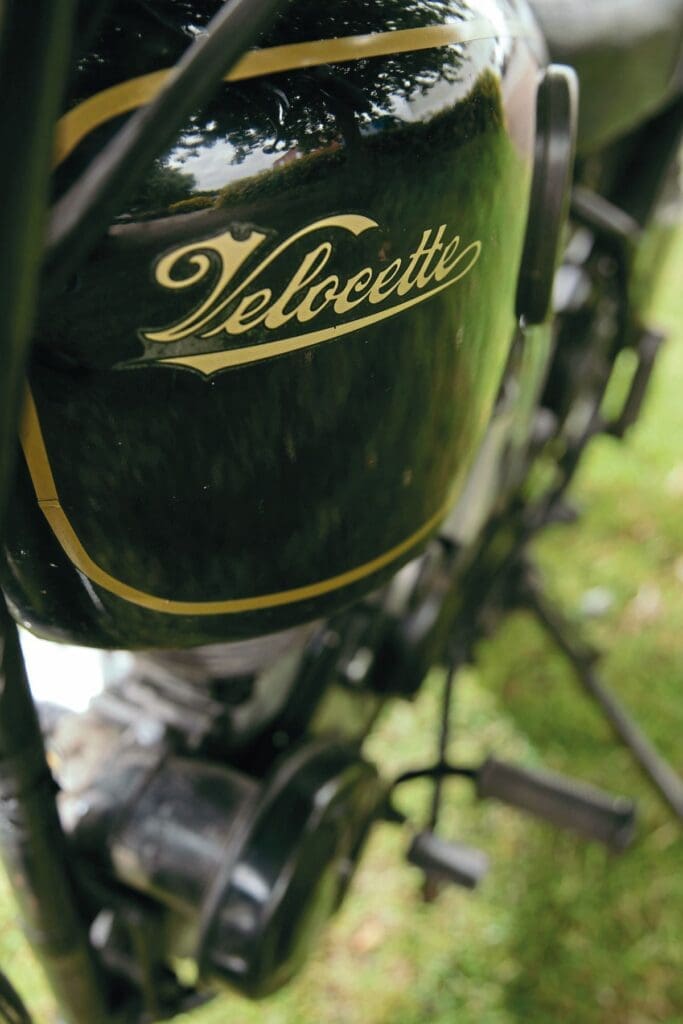
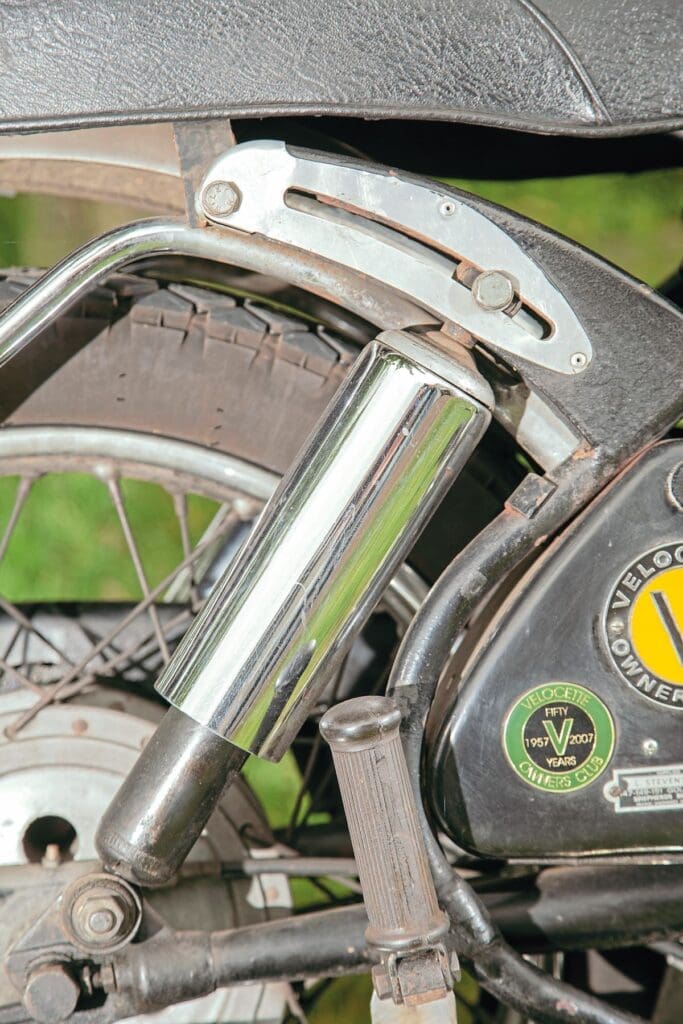
The MSS was quickly joined by the Venom in 1955, which came with bigger valves and ports. There was the Venom Clubman, which came with ace bars, rearsets and Amal TT carburettors, sometimes mated with the very chic Avon Veeline fairing. The final iteration, the Thruxton, was the ultimate sporting Velocette single, coming with a reworked head, reduced valve angles, more compression and an Amal GP carb mounted on a finned spacer to provide the optimum length of inlet tract, resulting in the creation of the signature petrol tank cut-out to make it fit. Velocette kitted out the first Thruxton models with tanks, mudguards and battery boxes in silver and with blue frames, but buyers asked for black and gold, and that is what subsequent models were mostly clad in. A rare model was the 1962-1969 Venom Special, a lower-priced model with paint instead of chrome, an old MSS tank, lower enclosures and a 95mph top speed. It came in blue and was about 5% cheaper than a stock Venom. Few were sold.
More than a few MSSs have been turned into Venom-spec machines. Indeed, it was owners tuning MSS bikes for speed that led to Velocette creating the Venom in the first place.
An MSS will cruise at 70mph, scratch at 80mph, yet vibration is only noticeable at about 60mph, with just a faint buzz the rest of the time.
The MSS stayed in the catalogue until Velocette closed in February 1971, although production may have finished as early as 1968, with plummeting demand for such an old-style bike, meaning that it was the Venom Clubman and Thruxton models that a dwindling number of buyers wanted.
As the basic bike changed little from the 1950s onwards and the design is so refined, parts availability is excellent. Most Velocette owners seem to be amateur or professional engineers. Or if they aren’t when they buy one, they soon become them.
Starting your MSS – myth vs truth
Starting can be a challenge, because of the kick-start gearing. On most old bikes, the kick-start is linked to the mainshaft of the gearbox and a single kick should turn the engine over twice. The Velocette kick-start works off the lower layshaft and for each kick this turns the engine over once, hence the model’s legendary reluctance to start, especially if it has not been timed, tuned, and put together with care. It requires patience, learning and technique to master the long, swinging kick needed to bring it into life. Follow thus: you flood the carb, find top dead centre (TDC), pull in the valve lifter, let the pedal return to the top, and then push it down all the way to the stop. Then you let it return to TDC and give it that long, swinging kick, following the stroke through all the way to bottom dead centre. At this point it should start if everything has been set up properly. Even when you have got it running, you shouldn’t leave it to tick over unattended as you gather up the sweat-stained riding gear you have cast about you. If you do, the bike can jump into second gear all by itself and throw itself to the floor in a toddler-ish tantrum.

The Velocette clutch
This is a thing of mystery and wonder. It is mounted inboard of the final drive sprocket, and the mechanism is very slender. Unlike a more conventional clutch which might have a central pushrod, the plates are separated by a bush that pushes on one side of the centre so the plates ‘peel’ off. There are 16 tiny springs mounted in a ring behind the slender clutch basket. The clearances between the plates are narrow and riding the clutch rather than slipping into neutral could mean those clearances could run out quickly. If it does, you have to remove a cover plate on the chaincase and insert the special Velocette clutch adjusting tool, which is a steel rod with a flat on one edge. Then, with the wheel aloft, you must rotate the rear wheel to adjust the clutch.
Velocette hid the cable adjuster under the petrol tank on later models to discourage inexperienced riders from trying to inexpertly fiddle with it, as you cannot adjust the clutch this way.
Velocette legend Titch Allen recommended that the only way to rebuild a Velocette clutch, even for an expert, is to follow the clutch assembly procedure in the special Velocette clutch manual to the letter. He also said: “It [the clutch] can in many ways be likened to a beautiful woman. It is slim but surprisingly strong, feather-light to the touch when handled correctly, but a perfect devil when mauled by uncouth hands. Capricious one moment, captivating the next.”
Much like the whole bike…
Opinions
In 1964, Cycle magazine tested an MSS scrambler: “In perfectly standard showroom trim, the Velocette is powerful enough to get right up there and tussle with everyone but the hottest of the hot-dogs. When all is said and done, if the rider of a Velocette does not see his name somewhere in the win-place-show listing, he cannot in fairness blame the machine; it has most of what it takes, and the rest can be added without too much trouble or expense.”
Titch Allen said: “It takes courage to drop out from the rat-race of multis and a different colour scheme every year and chrome with everything. Being different from the rest binds Velocette owners into a tight-knit cult. The characteristic weaknesses of the single cylinder design, the ritual of starting, the low periodicity vibration which is not felt by the rider but is death to mudguard stays and oil tank lugs and the mysterious clutch provides an initiation to the cult which effectively sorts out the men from the boys.”
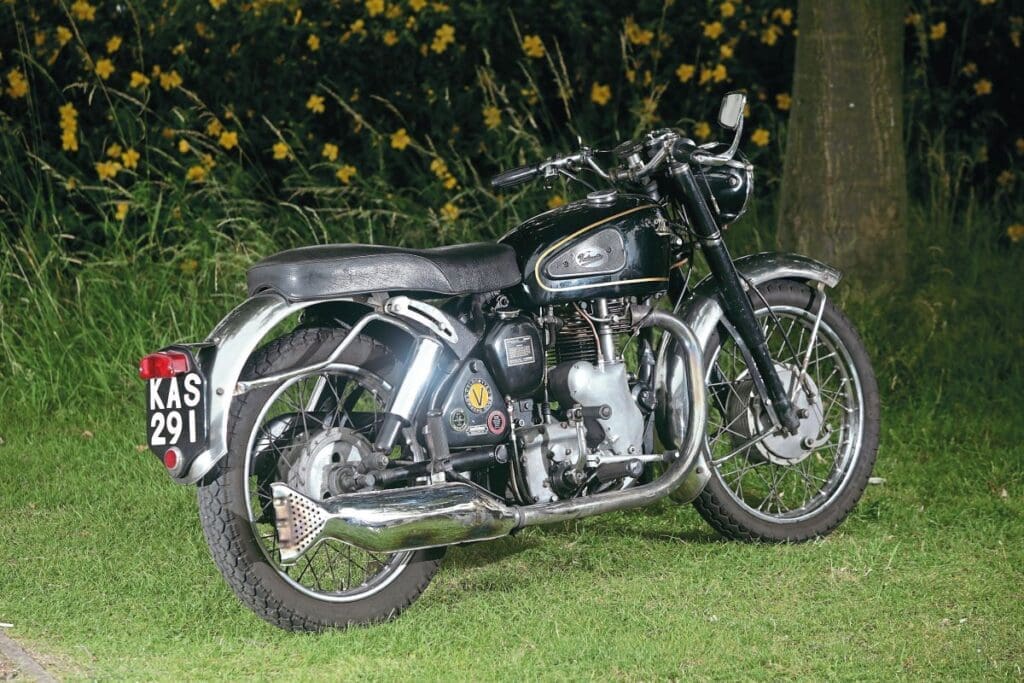
Buying bikes and spares
Spares availability is good for Velocettes. There are several specialist suppliers, Grove Classics being among the most notable. The owners’ club runs a comprehensive spares operation as well and manufactures small batches of spares. There are suppliers offering 12v conversions, starter motor kits, belt primary drives and five and six-speed gearbox conversions. The Velocette Owners’ Club magazine, a well put-together publication, will usually have machines in the For Sale section in various states from projects in boxes starting at £3500 to fully-restored models for somewhere about £6000-£8000, and classic dealers will occasionally pick up good examples, too.
Specification
MANUFACTURED: 1935-1968 ENGINE (from 1953): Air-cooled OHV high cam single BORE/STROKE: 86mm x 86mm CAPACITY: 499cc POWER: 25-36bhp @ 5000rpm LUBRICATION: Dry sump, gear pump IGNITION: BTH magneto CARBURETTOR: Amal 376 Monobloc 1 1/16 in TRANSMISSION: Chain GEARBOX: Four-speed foot change FRAME: Brazed lug chrome-moly tube, single downtube duplex cradle FRONT SUSPENSION: Veloce tele forks, hydraulic damping REAR SUSPENSION: Twin Woodhead Monroe/Girling shocks FRONT BRAKE: 7.5in sls drum full-width iron hub REAR BRAKE: 7in sls drum, full-width iron hub TYRES: 3.25 x 19 WHEELBASE: 54in GROUND CLEARANCE: 6in SEAT HEIGHT: 31in DRY WEIGHT: 375lb TOP SPEED: 85-95mph (depending on model)
Specialists
Grove Classics: groveclassicmotorcycles.com
Veloce Spares (Owners’ Club Members Only): www.velocespares.co.uk
OWNERS’ CLUB
Velocette Owners’ Club: www.velocetteowners.com

